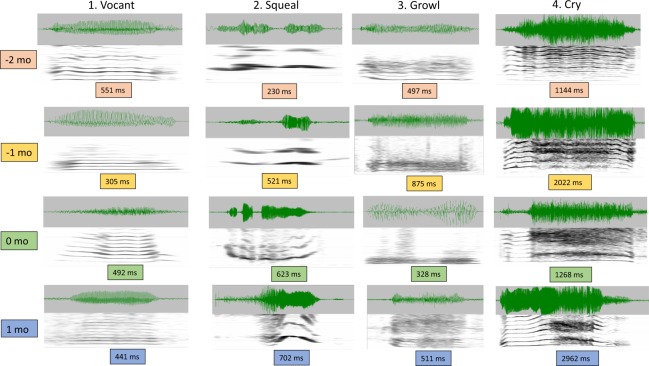Figure 1.
Spectrographic examples of vocalizations in preterm and full-term humans. Protophones (vocants, squeals, and growls) are displayed in the first three columns and cries in the fourth. Nearly all infants (all preterms and 11 of 12 full terms), produced all three protophone types (>40,000 observed). 18 of 20 preterms produced cries, whereas cries were represented for all the full term infants (>6,000 observed). A time domain display is provided at the top of each of the 16 examples, and spectrographic displays are provided at the bottom of each (range 4–5 kHz, 30 Hz bandwidth). The examples were produced by four different infants at each age in each of the four columns. Human infant sounds are extremely variable; every utterance of any of these infant vocal categories is distinct, yet the four categories of sounds represented in the figure’s columns correspond to auditorily identifiable exemplars of the categories as labeled. Wave files for each of the examples are available in Supplementary Information. (1) Vocants (or vowel-like sounds): By far the most frequent protophone category (>70% of all protophones at all ages), vocants show little interharmonic noise throughout all four exemplars. Vocants are usually produced in comfort. (2) Squeals: Produced with very high pitch, indicated by periods of widely-spaced harmonics; squeals represented ~7% of protophones, occurring in all but 3 infants. (3) Growls: these exemplars include considerable interharmonic noise and pitch lower than squeals. Some growls also include periods of very low pitch in a phonatory pattern called vocal fry (or pulse). Growls represented ~15% of protophones, and occurred in all the infants. (4) Cry: All four exemplars show human-typical, evenly-spaced harmonics (normal phonation) at the beginning of each of the cries, followed by significant and auditorily salient periods of dysphonation (sometimes called harsh phonation) in each of the four, corresponding to chaotic and/or subharmonic phonatory regimes. The pattern of normal phonation followed by dysphonation and then normal phonation again has been argued to constitute the most prototypical form of intense human infant cry83.

